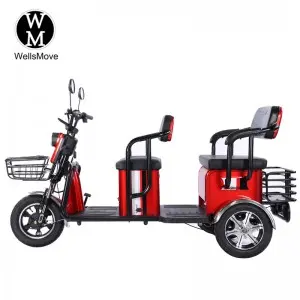How to detect and repair the motor bearing problems of elderly tricycles
Introduction
With the aging of the population, elderly tricycles have become an important means of transportation for many elderly people. For international wholesale buyers, it is crucial to understand the common problems and repair methods of elderly tricycles, which can not only help you provide better services to customers, but also enhance your competitiveness in the market. This article will focus on how to detect and repair the motor bearing problems of elderly tricycles.
1. The importance of motor bearing problems
The motor bearing is one of the key components of elderly tricycles, which directly affects the running stability and safety of the vehicle. If there is a problem with the bearing, it may cause abnormal noise and vibration when the vehicle is driving, and even affect the normal operation of the motor, thereby shortening the service life of the motor, causing inconvenience and safety hazards to the travel of the elderly.
2. Methods for detecting motor bearing problems
Auditory inspection: Listen carefully to the sound of the motor part during the operation of the vehicle. If you hear a continuous “buzzing” sound or other abnormal noise, this may be caused by lack of oil or wear of the bearing.
Observation inspection: Check whether the vehicle has abnormal vibration when driving. If the vibration increases significantly, especially when accelerating or turning, this may mean that the bearing is faulty.
Touch check: After the motor stops running, carefully touch the motor housing. If the motor feels overheated, it may be that the motor is overloaded due to bad bearings, causing heating.
Professional tool detection: Use professional equipment such as vibration detectors or infrared thermometers to detect motor bearings. Vibration detectors can accurately measure the vibration amplitude of the motor when it is running, helping you determine whether the bearings are worn or unbalanced; infrared thermometers can quickly detect the temperature distribution of the motor housing and promptly detect overheating caused by bearing problems.
3. Steps to repair motor bearing problems
Prepare tools and materials: Before starting the repair, you need to prepare tools and materials such as screwdrivers, wrenches, new bearings, cleaners, grease, etc.
Disconnect the power supply: To ensure the safety of the repair process, first turn off the power supply of the elderly three-wheeled scooter and disconnect the battery to prevent electric shock accidents during the repair process.
Disassemble the motor: Use a screwdriver to remove the screws on the motor housing, and then carefully remove the motor from the tricycle. During the disassembly process, be sure to record the position and connection of each component so that it can be accurately restored when reinstalled.
Remove the old bearing: After opening the motor housing, you will see the bearing inside. Use a screwdriver or other suitable tool to remove the old bearing from the motor shaft. If the bearing is tight, you can gently tap the outer ring of the bearing to loosen it before removing it.
Cleaning and inspection: Before installing the new bearing, thoroughly clean the inside of the motor to remove dust, oil and other impurities. At the same time, carefully check whether the motor shaft and bearing mounting seat are worn or deformed. If necessary, they should be repaired or replaced.
Install the new bearing: Install the new bearing on the motor shaft and ensure that the bearing fits tightly and evenly with the shaft. During the installation process, you can use some grease to help the bearing fit more easily, and the grease can also play a certain lubrication and rust prevention role.
Reassemble the motor: Reinstall the motor housing on the motor and tighten the screws with a screwdriver. Make sure that the motor housing fits tightly with the internal components to ensure the normal operation of the motor.
Test the motor: Reinstall the motor on the tricycle and connect the power supply. Start the tricycle, let the motor idle for a while, observe the operation of the motor, and check for abnormal noise, vibration or overheating. If everything is normal, perform a load test to ensure the performance and reliability of the motor under normal working conditions.
4. Recommendations for preventing motor bearing problems
Regular maintenance: It is recommended to maintain the motor bearings of the elderly tricycle every quarter or every six months, including cleaning, inspection and lubrication. Regularly replace the grease to keep the bearings in good lubrication and reduce wear.
Correct use of the vehicle: Remind customers to avoid long-term overload operation when using the elderly tricycle, and do not start and brake frequently to avoid excessive impact and load on the motor bearings. At the same time, try to avoid driving on uneven roads to reduce vehicle bumps and vibrations.
Timely maintenance: If you find a problem with the motor bearing, repair or replace it in time to avoid the expansion of the fault, resulting in more serious damage and higher maintenance costs.
5. Summary
The motor bearing problem is one of the common but important problems of elderly tricycles. By mastering the correct detection method, potential problems of the bearing can be discovered in time, so that effective maintenance measures can be taken to ensure the normal operation of the vehicle and the travel safety of the elderly. At the same time, preventive measures are also crucial, which can effectively extend the service life of the motor bearing and reduce the frequency and cost of maintenance. As an international wholesale buyer, understanding these knowledge and skills will help you provide customers with better products and services and enhance your competitiveness in the elderly tricycle market.
Post time: May-12-2025



